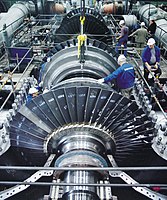
Photo from wikipedia
More than 226 million people are affected by some type of disaster every year in various dimensions of human life, both in the short and long term. In this context,… Click to show full abstract
More than 226 million people are affected by some type of disaster every year in various dimensions of human life, both in the short and long term. In this context, housing provision plays a leading role when it comes to basic needs and the choice of construction technologies and materials are determinant for a well-succeeded housing provision process. This work aims to analyze the viability of reinforced masonry technology with cement-stabilized compressed earth blocks as an alternative for the (re)construction process in situations that involve disaster risk reduction (DRR). To address this issue, a discussion from the literature and the main results obtained during the investigations carried out within the scope of the Simple Housing Solution (SHS) Project are presented. In the sequence, analyses are performed under United Nations Development Program/International Recovery Platform sustainability recommendations: environmental, technical, financial and socio-organizational aspects. It is concluded that the technology of Compressed Earth Blocks (CEBs) reinforced structural masonry has a high potential to be successfully applied in DRR situations, especially when associated with the community construction system in a joint effort.
Journal Title: Materials
Year Published: 2020
Link to full text (if available)
Share on Social Media: Sign Up to like & get
recommendations!